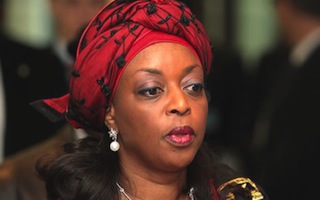30th December, 2014

Petroleum Minister and OPEC President
Almost half of Nigeria’s cargoes due to be exported in January are still available, Reuters has reported, even as oil prices reach the $50s trough, ten dollars below Nigeria’s benchmark price.
The backlog has pushed Nigerian oil differentials versus Brent to their lowest since at least 2009 BFO-QUA at 65 cents a barrel, down 80 percent since May, said Reuters. And it is also creating a discount frenzy between African and Gulf oil producers to Asian buyers
Asia has become a hotspot for a price war between African and Gulf oil producers who, hobbled by bulging global supplies and waning demand, are offering steep discounts to defend their market share in the world’s top net crude buying region.
The competition is welcome news for Asian buyers. If oil stays near $60 per barrel, import costs for the world’s No.2 oil consumer, China, would drop to under $125 billion a year, versus $222 billion in 2013 when crude averaged $110.
But for producers it means more competition, and African sellers like Nigeria and Angola, faced with precarious finances due to plummeting oil prices, are struggling to make inroads into Asia, a Middle Eastern stronghold.
“There is competition between West African and Middle East suppliers for the Asian markets, but the Middle East suppliers have the cost advantage,” said Philip Andrews-Speed, head of Energy Security Division at the National University of Singapore. The city-state is a major oil trading hub in Asia.
Low operating costs in Saudi Arabia, Kuwait and the Emirates already allow these countries to offer hefty discounts.
Now, a more than 50 percent jump in freight rates between West Africa and China since September is adding to the relative advantage of Middle Eastern grades, which require shorter shipping distances to Asia.
This has been a big setback for West African producers.
West African exports got a brief boost in August when Brent’s premium to Middle East crude DUB-EFS-1M narrowed to less than $2 per barrel from almost $5 in June. But with Middle Eastern producers now offering even more competitive prices, the advantage has faded.
“A year ago, a $2 premium would have been attractive, but in today’s environment it’s different,” a trader dealing with West African crude said.
Meanwhile, oil prices traded near five-year lows in thin year-end trade Tuesday, as analysts predicted further bearishness in the market owing to rising United States production despite a global supply glut.
West Texas Intermediate for February delivery fell 49 cents to $53.12 while Brent crude for February lost 55 cents to $57.33 in afternoon trade.
WTI closed down $1.12 to $53.61 in New York while Brent fell 57 cents in London to $57.88. Both contracts last traded at those levels in May 2009.
“We are seeing light volumes in Asian trading… oil prices have once again touched new lows over longer term concerns about US production levels,” Michael McCarthy, chief market strategist at CMC Markets in Sydney, told AFP.
“Bullishness is contained, and I think we will be seeing a consolidation pattern as we head to the close of the year,” he added.
Oil has shed about half its value since June, attributed to slowing growth in China and emerging-market economies, a recession in Japan and a near-stall in the eurozone.
On top of that, the OPEC oil-producing cartel last month said it would maintain output levels despite ample global supplies, in part due to cheaper oil extracted from North American shale rock.
Analysts said traders were also girding for more downward pressure stirred up by the impact of a brewing Greek political crisis, expected poor numbers on China’s industrial sector, and another possible increase in US stockpiles.
The US Energy Information Administration will on Wednesday release stockpiles data for the week to December 26.


